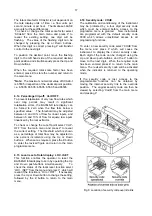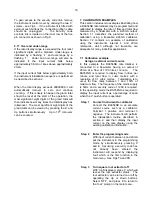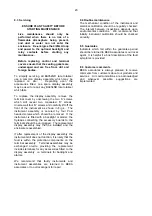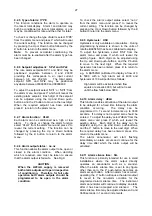
27
9.2.5 Type of alarm: tYPE
This function conditions the alarm to operate on
the rate or total display. Alarm 1 and Alarm 2 may
both be conditioned as rate or total alarms, or one
may be conditioned for rate and the other for total.
To check or change the type of alarm, select 'tYPE'
from the alarm menu and press
P
which will reveal
the current setting. The function can be changed
by pressing the
Up
or
Down
button followed by the
E
button to return to the alarm menu.
Note:
To prevent accidental conditioning the
alarm must be re-enabled after the alarm Type has
been changed.
9.2.6 Setpoint adjustment: SPx1 and SPx2
The rate alarm setpoints SPr1 and SPr2 may be
positioned anywhere between 0 and 20000
providing this corresponds to an input current
between 3.8 and 20.2mA. The total alarm
setpoint SPt1 and SPt2 may be positioned
anywhere between 00000000 and 99999999
To adjust the setpoint select 'SPr1' or 'SPt1' from
the alarm menu and press
P
which will reveal the
existing alarm setpoint. Each digit of the setpoint
can be adjusted using the
Up
and
Down
push-
buttons, and the
P
button to move to the next digit.
When the required setpoint has been entered
press
E
to return to the alarm menu.
9.2.7 Alarm function: HI.LO
Each alarm can be conditioned as a high or low
alarm. To check or change the alarm function
select 'HI.LO' from the alarm menu and press
P
to
reveal the current setting. The function can be
changed by pressing the
Up
or
Down
buttons
followed by the
E
button to return to the alarm
menu.
9.2.8 Alarm output status: no.nc
This function allows the alarm output to be open or
closed in the alarm condition. When deciding
which is required, care must be taken to ensure
that the alarm output is fail safe. See Fig 9.
CAUTION
When the 4/20mA supply is removed
both alarm outputs will open irrespective
of conditioning. Therefore for fail safe
operation both alarm outputs should be
programmed to be open in the alarm
condition.
To check the alarm output status select 'no.nc'
from the alarm menu and press
P
to reveal the
current setting. The function can be changed by
pressing the
Up
or
Down
button followed by the
E
button to return to the alarm menu.
9.2.9 Hysteresis: HStr
Hysteresis is only available on rate alarms. During
programming hysteresis is shown in the units of
rate the BA354ND has been calibrated to display.
To adjust the hysteresis, select 'HStr' from the
alarm menu and press
P
which will reveal the
existing figure. Each digit can be adjusted using
the
Up
and
Down
push-buttons, and the
P
button
to move to the next digit. When the required
hysteresis has been entered, press
E
to return to
the alarm menu.
e.g. A BA354ND calibrated to display a flow of 0
to 5000, with a high alarm set at 4000 and
hysteresis of 100 will perform as follows:
High alarm will be activated when flow
equals or exceeds 4000, but will not reset
until the flow falls below 3900.
9.2.10 Alarm delay: dELA
This function enables activation of the alarm output
to be delayed for a fixed time following the alarm
condition occurring. The delay can be
programmed in 1 second increments up to 3600
seconds. If a delay is not required zero should be
entered. To adjust the delay select 'dELA' from the
alarm menu and press
P
which will reveal the
existing delay. Each digit of the delay can be
adjusted using the
Up
and
Down
push-buttons,
and the
P
button to move to the next digit. When
the required delay has been entered, press
E
to
return to the alarm menu.
The alarm annunciator will start flashing
immediately an alarm occurs and continue for the
delay time after which the alarm output will be
activated.
9.2.11 Alarm silence time: SIL
This function is primarily intended for use in small
installations where the alarm output directly
operates an annunciator such as a sounder.
When the alarm silence time is set to any figure
other than zero, the
P
push-button becomes an
alarm accept button. After an alarm has occurred,
operating the
P
button will cause the alarm output
to revert to the non-alarm condition for the
programmed alarm silence time. The instrument
alarm annunciator will continue to display an alarm
after it has been accepted and silenced. The
alarm silence time may be adjusted between 0 and
3600 seconds in 1 second increments.




































